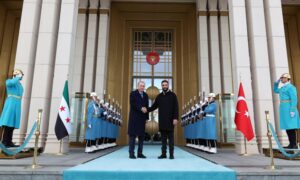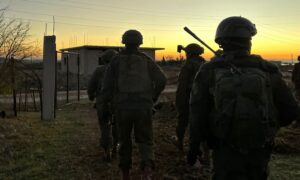
Regime Cuts Homs and Hama Countrysides Into Three Pockets

Assad forces split their fighting fronts in Syria’s central regions, practically encircling ISIS forces in the area, Enab Baladi reports
President Bashar al-Assad and his allied militias have come to benefit from the events in the countrysides of Homs and Hama at the expense of Islamic State (ISIS), which has come under siege in the town of Aqairbat east of the city of Suleimaniyah after military operations from different directions divided the area into three pockets, each one no more than 250 square kilometers.
The regime’s advance in the battle against ISIS came with heavy military armaments, after the “de-escalation zones” agreement froze other military fronts in other Syrian provinces.
According to the map of control, the Assad forces’ first axis came from the town of Al-Sakhna in the eastern countryside of Homs, which they have controlled since the start of August, while the second axis is concentrated from the southern Raqqa countryside up to the Tueinan and Akram oil fields.
The third axis through which ISIS had been put under siege is in the Hama countryside, and extends from the southern Aleppo countryside up to the eastern Homs countryside.
Islamic State cut off from Deir-ez-Zor
Syrian state media reported on Aug. 18 that “units of the Syrian army, in cooperation with local forces, imposed a siege on a large group of the ISIS organization in the town of Aqairbat.”
The Ammaq news agency, the ISIS’ official mouthpiece, did not clarify the details of the fighting in the area, but in an announcement it claimed the deaths of dozens of Assad forces fighters during counterattacks on their positions.
Assad’s forces entered into the fighting in the area months ago, and the control of Al-Sakhna improved its fortunes in making the western axis from the Al-Shula node toward the Aqairbat intersection possible and put the town under siege.
With the siege on ISIS, any connection between its forces east in Deir-ez-Zor and west in the Aqairbat pocket and the Salamiyah borders has been cut off.
Assad’s forces have set their sights on the Balas Mountains in the Hama and Homs countryside, which has put ISIS in a critical situation.
The swift advance came after advancing 21 kilometers toward the villages of Khirbat Makman and the town of Al-Kedeer south of Raqqa, alongside a distance of 12 kilometers east of the city. This occurred after taking control of Bir al-Rahoum following an air drop for the first time on Friday evening 20 kilometers behind ISIS lines on the border between Raqqa and Homs.
Geography encircles the organization
The Aqairbat area in the eastern Hama countryside has been under ISIS control since 2014 and is located in the Syrian interior. It extends from the eastern countryside of the city of Salamiyah up to the administrative border with Raqqa province, and is alongside the Balas Mountains area, which is also under the organization’s control in the Homs countryside from the southern side.
This has been a launching pad for the organization’s attacks toward Salamiyah since 2014. One of the bloodiest events was a surprise attack on the town of Al-Mabaoojah in April 2015, which resulted in no fewer than 60 deaths and dozens of wounded, in addition to prisoners and missing.
The event was repeated two years later on May 18, when the organization attacked the town of Aqarib and carried out a massacre that also left about 60 dead, including civilians and soldiers from Assad’s forces.
Its strategic importance is due to the fact that it comprises a geographical convergence point with the ISIS areas in the provinces of Aleppo, Raqqa and Homs, and is considered the only outlet for ISIS in the area.
Assad’s forces and foreign and local militias are participating in the battle, most notably Lebanon’s Hezbollah, the Qalamoun Shield and the Tiger Forces under the leadership of Suheil al-Hassan.
The battle of the regime forces and their allies against the ISIS coincides with battles that have been ongoing for six months in the group’s stronghold of Raqqa, whose pace has increased over the last two months, led by the Syrian Democratic Forces, a Kurdish-Arab alliance backed by the United States and the international coalition. It has neared taking full control over the city after entering deep into its neighborhoods.
This article was translated and edited by The Syrian Observer. Responsibility for the information and views set out in this article lies entirely with the author.
if you think the article contain wrong information or you have additional details Send Correction
النسخة العربية من المقال
-
Follow us :
Most viewed
- Syrian Defense Ministry appoints "Abu Amsha" as Hama Brigade commander
- SDF faces two fronts... Damascus negotiates and Ankara wants war
- Former Syrian Interior Minister Mohammad al-Shaar surrenders to authorities
- Al-Sharaa meets Bin Salman: Together towards a true partnership
- Syrians hope for a new state without "wasta"

















 A
A
A
A
A
A








 More Politics
More Politics